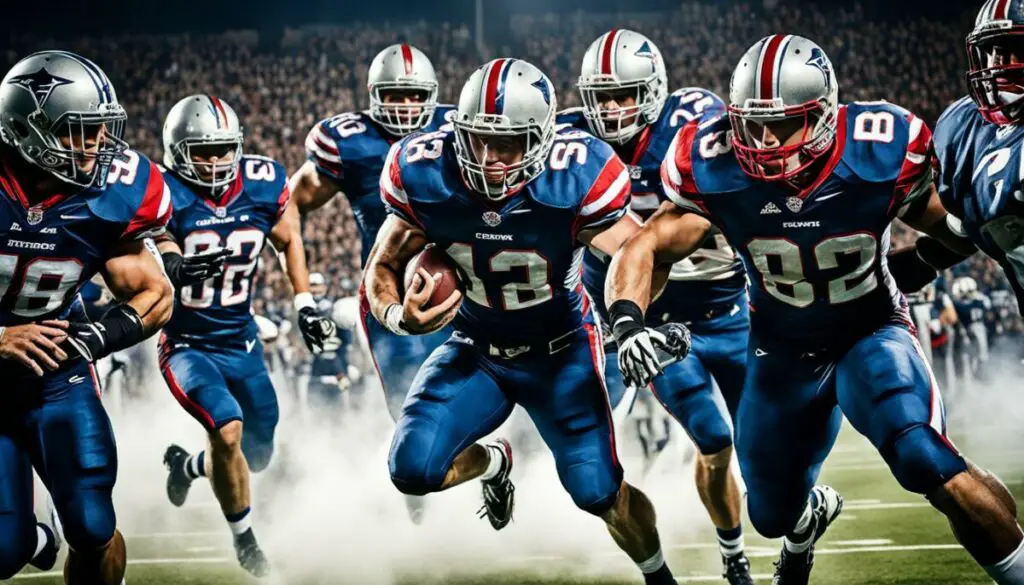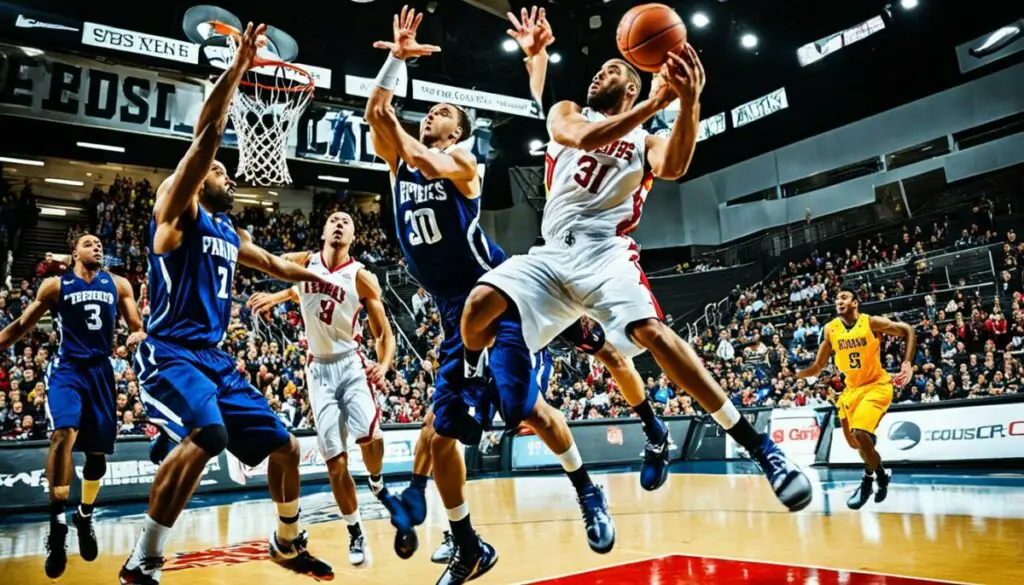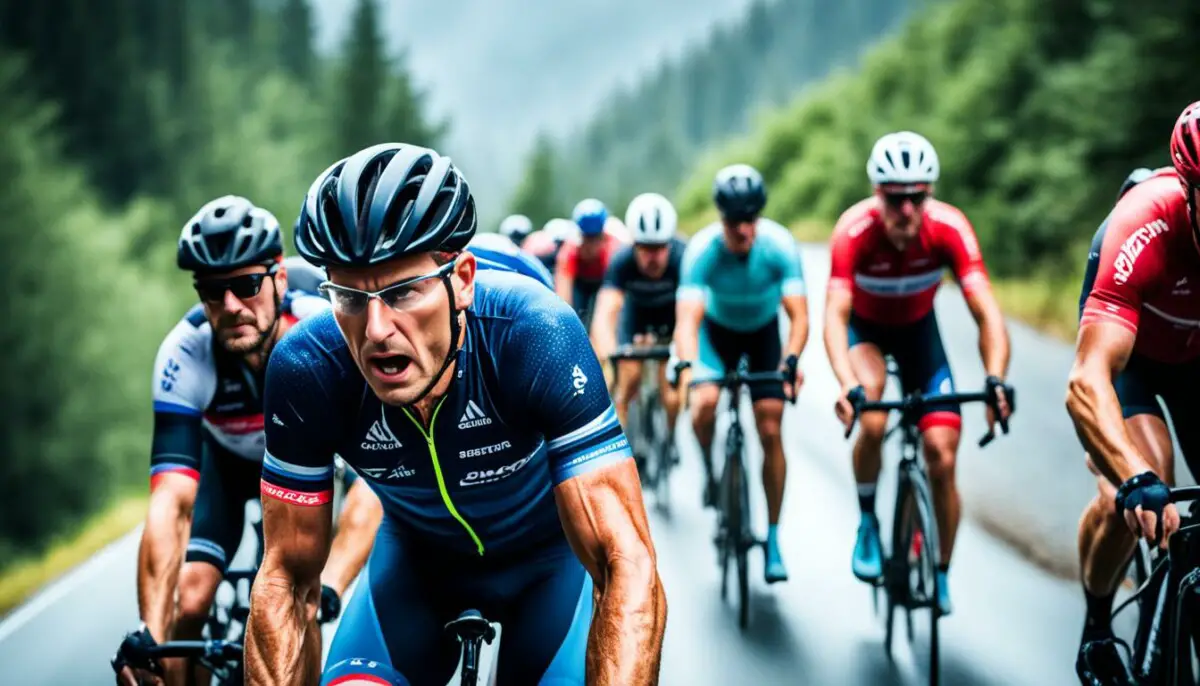Last Updated on 3 months by Francis
When it comes to physically demanding sports, athletes push their bodies to the limit, showcasing incredible feats of strength, endurance, and skill. But which sports are the most demanding? A detailed analysis conducted by ESPN has revealed the top physically demanding sports that athletes participate in today.
Contents
Key Takeaways:
- Boxing is ranked as the most physically demanding sport, requiring high levels of endurance, strength, power, and agility.
- Ice hockey combines high-intensity skating, reflexes, and physical contact, making it a grueling and fast-paced game.
- American football demands a combination of speed, strength, stamina, and agility, with high impact collisions and demanding plays.
- Basketball requires constant movement, energy expenditure, cardiovascular fitness, and strength for an intense game on the court.
- Wrestling tests athletes both mentally and physically, with grappling, takedowns, and maneuvers that strain the body.
These physically demanding sports challenge athletes in various ways, highlighting the incredible capabilities of the human body. Stay tuned to discover more intense physical activities in our further sections.
Boxing Tops the List
Boxing has been identified as the most physically demanding sport in a comprehensive analysis conducted by ESPN. It is a sport that demands exceptional athleticism and pushes athletes to their limits both physically and mentally. The rigorous training regimen and intense bouts in the ring make boxing one of the most physically demanding sports.
In boxing, athletes need to possess high levels of endurance, strength, power, and agility. They must be able to deliver swift and powerful punches while maintaining quick footwork and defensive maneuvers. The combination of skill, strategy, and sheer physicality required in boxing makes it one of the most demanding athletic disciplines.
“Boxing is not just about throwing punches; it’s about using your entire body efficiently and effectively in the ring. It’s a physical chess match that requires mental and physical toughness” – Mike Tyson
The intense physical demands of boxing can be seen in the training routines undertaken by professional boxers. Hours of high-intensity cardiovascular exercises, strength training, and sparring sessions build their endurance, power, and technique. Furthermore, the bouts themselves are grueling tests of stamina, skill, and willpower.
Boxing, with its physically demanding nature, is a sport that truly exemplifies the remarkable capabilities of the human body. It showcases the dedication, discipline, and determination required to excel in one of the most intense physical sports. Whether it’s in the training gym or the boxing ring, athletes demonstrate their unwavering commitment to the sport, pushing themselves beyond their limits to achieve greatness.
The Grueling Nature of Ice Hockey

Ice hockey is another highly physically demanding sport that involves high-impact and fast-paced activities. Players engage in high-intensity skating, quick reflexes, and physical contact, creating a challenging and intense game. To excel in this demanding sport, athletes need to possess excellent endurance, strength, agility, and hand-eye coordination.
The constant physicality of ice hockey puts immense strain on the body, making it one of the most physically demanding activities. Players endure grueling shifts on the ice, constantly battling for the puck and positioning themselves in a fast-paced environment.
Skating is a crucial aspect of ice hockey, requiring players to have exceptional cardiovascular fitness and lower body strength. The rapid movements and transitions from skating forward to backward and changing directions put immense pressure on the legs and core muscles. Additionally, quick reflexes and split-second decision-making are essential for both offensive and defensive plays, making ice hockey mentally demanding as well.
In the high-impact sport of ice hockey, collisions and body checks are common occurrences. Players must possess resilience and durability to withstand the physical demands of the game. The combination of speed, physicality, and endurance pushes athletes to their limits, emphasizing the intense nature of this sport.
Ice hockey exemplifies the physically demanding activities that athletes undertake to compete at the highest level. The game’s combination of speed, strength, and skill makes it a challenging and thrilling sport to watch and participate in.
Key Points:
- Ice hockey is a highly physical and demanding sport.
- Athletes require endurance, strength, agility, and hand-eye coordination to excel in the game.
- High-impact, fast-paced activities contribute to the grueling nature of ice hockey.
- Skating, reflexes, and physical contact are essential elements of the sport.
- Ice hockey tests athletes’ physical and mental capabilities due to constant physicality and quick decision-making.
| Attribute | Description |
|---|---|
| Endurance | Ice hockey requires exceptional cardiovascular fitness due to the high-intensity nature of the game. |
| Strength | Players must possess the physical strength necessary for skating, shooting, and engaging in physical battles on the ice. |
| Agility | Quick changes of direction and swift movements are essential skills in ice hockey. |
| Hand-eye coordination | Precise puck handling and accurate passing require excellent hand-eye coordination. |
The Rigors of American Football

American football is renowned for being one of the most physically demanding and challenging sports. Players in this intense game need to possess a unique combination of speed, strength, stamina, and agility to excel on the field. The high-impact collisions and physically demanding plays make football a grueling sport that tests the limits of an athlete’s endurance and toughness.
Emphasizing its physically demanding nature, the sport of American football pushes athletes to their physical and mental limits. The power and precision required to execute plays effectively demand exceptional athleticism and coordination. Additionally, the physicality of the sport puts players at risk of injuries and requires them to be mentally sharp to make split-second decisions.
“American football is a sport where every player on the field needs to be physically and mentally tough. It’s a physically demanding sport that pushes your limits and tests your mental resilience.” – Tom Brady, legendary NFL quarterback
From the explosive bursts of speed during sprints to the intense collisions experienced during tackles and blocks, football demands a high level of physicality. The players must endure the grueling nature of the game, pushing through fatigue and physical discomfort, all while maintaining focus and performing their assigned roles on the field.
The physically demanding nature of American football highlights the athleticism and dedication required from its players. It is recognized as one of the most challenging sports not only in terms of physical exertion but also mental fortitude. Athletes who participate in this sport must possess a relentless work ethic and an unwavering commitment to their craft.
Physical Demands of American Football:
- Prolonged endurance to sustain the physical intensity throughout a game
- Explosive power for quick bursts of acceleration
- Strength for tackling, blocking, and carrying the football
- Speed and agility to maneuver through opponents and complete plays
- Mental toughness to withstand physical challenges and maintain focus under pressure
American football demands a combination of physical attributes that make it one of the most physically demanding and challenging sports in the world. The rigorous training and preparation required to excel in this sport are a testament to the dedication and commitment of its athletes.
The Intensity of Basketball

Basketball is a physically demanding sport that requires athletes to constantly move and exert high levels of energy. The fast-paced nature of the game, combined with the need for speed, agility, and endurance, makes basketball one of the most intense sports. Athletes must possess excellent cardiovascular fitness, strength, and coordination to excel on the court. The constant running, jumping, and quick changes in direction make basketball a physically demanding activity.
The Rigors of the Game
As players sprint up and down the court, engage in fast breaks, and perform demanding maneuvers, the physical demands of basketball become evident. The sport requires a unique combination of endurance to keep up with the fast pace, explosive power for jumps and quick movements, and agility for rapid changes in direction.
“Basketball is like poetry in motion. It’s fast, it’s demanding, and it’s beautiful to watch.” – LeBron James
Not only do basketball players require exceptional physical attributes, but they also need to have mental toughness to handle the intense pressure of the game. The competitive nature of basketball and the need to make split-second decisions demand focus and resilience.
The Physical Benefits
In addition to being an intense sport, basketball offers numerous physical benefits. The fast-paced nature and constant movement provide a cardiovascular workout, improving heart health and endurance. The explosive jumps and quick movements strengthen leg muscles and enhance agility. The constant running also helps athletes maintain a healthy weight and improve overall body composition.
The Importance of Conditioning
To meet the physical demands of basketball, athletes must prioritize conditioning and training. This includes regular practices, focused drills, and strength and conditioning exercises. A well-rounded training program should address endurance, strength, speed, and agility to enhance performance and reduce the risk of injuries.
Whether played professionally or recreationally, basketball remains one of the most physically demanding and intense sports. Athletes who excel in this sport showcase their exceptional physical prowess and mental fortitude, captivating fans worldwide with their skill, speed, and excitement on the court.
The Physicality of Wrestling

Wrestling is a highly physical sport that tests athletes both mentally and physically. It requires strength, endurance, flexibility, and technical skill. The constant grappling, takedowns, and maneuvers put tremendous strain on the body, making wrestling one of the most physically demanding sports. Wrestlers must possess exceptional physical conditioning and mental toughness to succeed in this intense athletic discipline.
In addition to the physical demands, wrestling is also known for its high-impact nature. The close-quarter combat and strategic moves involved in the sport can result in significant force being exerted on the body. From powerful slams to bone-jarring holds, wrestlers must be prepared to withstand and deliver intense impacts. This combination of physicality and high-impact makes wrestling a challenging and demanding sport.
The Training Regimen of Wrestlers
Wrestlers undergo rigorous training regimens to develop the physical attributes required for the sport. These regimens often include strength and conditioning exercises, such as weightlifting, plyometrics, and cardiovascular workouts. Wrestlers also focus on developing flexibility, as it plays a crucial role in executing various moves and maintaining proper form during matches.
Mental toughness is equally important in wrestling. Athletes must possess the resilience to push through intense physical exertion, endure pain, and maintain focus during matches. This mental fortitude is developed through rigorous training and a relentless commitment to the sport.
The Physical Benefits of Wrestling
Engaging in wrestling offers numerous physical benefits. The sport helps athletes build strength and power as they constantly engage their muscles in grappling, lifting, and maneuvering their opponents. Wrestling also improves cardiovascular endurance, as matches often require sustained exertion for extended periods.
Aside from the physical benefits, wrestling instills discipline, self-confidence, and perseverance in its practitioners. The dedication and commitment required to excel in this demanding sport transfer to other areas of life, fostering personal growth and character development.
“Wrestling is not just about physical prowess, it’s about mental strength. The mental resilience built through the challenges of wrestling translates to every aspect of life.”
– Olympic gold medalist Jordan Burroughs
Injury Risk and Safety Measures
Given the physicality and high-impact nature of wrestling, there is an inherent risk of injury. Common injuries in wrestling include sprains, strains, dislocations, and concussions. However, athletes and coaches take several safety measures to mitigate these risks.
Proper conditioning, technique training, and supervised practice sessions help wrestlers develop the necessary skills and minimize the likelihood of injuries. Additionally, appropriate protective gear, such as headgear and knee pads, provide added safety during matches and practices. Coaches and trainers play a critical role in promoting safe practices and ensuring athletes engage in responsible training methods.
Martial Arts and Its Demands
Martial arts encompass various disciplines such as karate, jiu-jitsu, judo, and taekwondo, known for being physically demanding sports. These intense physical activities require athletes to possess strength, speed, flexibility, and exceptional control over their bodies.
The intense training regimens and demanding techniques make martial arts one of the most physically challenging activities.
Athletes who excel in martial arts must not only have strong overall fitness but also demonstrate mental discipline to overcome the physical and mental challenges these sports present. The combination of physical demands and mental fortitude required makes martial arts an intense and rewarding pursuit for athletes seeking to push their limits.
| Martial Arts Discipline | Physical Demands |
|---|---|
| Karate | Focuses on striking techniques, requiring strength, speed, and precision. |
| Jiu-Jitsu | Emphasizes ground fighting and submission holds, requiring strength, flexibility, and technical skill. |
| Judo | Focuses on throws and grappling techniques, demanding strength, agility, and timing. |
| Taekwondo | Emphasizes high kicks and fast strikes, requiring speed, agility, and flexibility. |
The Physical Elements of Tennis
Tennis is a sport that requires athletes to possess a combination of physical and technical abilities. Players must have excellent footwork, speed, agility, and endurance to cover the court and react to fast-paced rallies. The repetitive nature of the sport and the explosive movements required during serves and strokes make tennis a physically demanding activity. Players must maintain high levels of fitness and possess mental resilience to thrive in this demanding athletic discipline.
Players in tennis need to have quick reflexes and the ability to change direction rapidly, as they chase down balls on opposite ends of the court. The high-intensity nature of the game requires athletes to have good anaerobic and aerobic fitness levels to sustain long, grueling matches. Tennis matches can last several hours, and players need to be physically prepared to endure the physical and mental strain.
“Tennis requires a unique blend of physical and mental skills, making it one of the most demanding athletic disciplines. It demands speed, agility, endurance, and mental resilience.”
In addition to the physical demands, tennis also requires athletes to possess technical skills, such as shot placement, spin control, and precision. These skills, combined with the physicality of the game, make tennis a challenging and demanding sport that tests an athlete’s physical and mental capabilities.
Training Regimen and Fitness
To excel in tennis, players follow a rigorous training regimen that focuses on developing and maintaining the physical attributes needed for the sport. This includes strength and conditioning exercises, agility drills, cardiovascular training, and specialized workouts to enhance footwork and explosiveness.
Players also work on improving their overall flexibility to perform the dynamic movements required, such as powerful serves and quick lateral movements. Proper nutrition and hydration are essential to support the physical demands of the sport and aid in recovery.
The Importance of Mental Resilience
Besides the physical aspects, tennis is also a mentally challenging sport. Athletes must have the ability to stay focused, make quick decisions, and maintain composure under pressure. The mental aspect of tennis is crucial, as players need to strategize, adapt to opponents’ playing styles, and overcome setbacks during matches.
Physically Demanding Sports Comparison
| Sport | Physical Demands |
|---|---|
| Boxing | Endurance, strength, power, agility |
| Ice Hockey | High-intensity skating, physical contact |
| American Football | Speed, strength, stamina, agility |
| Basketball | Constant movement, speed, agility |
| Wrestling | Strength, endurance, flexibility |
| Martial Arts | Strength, speed, flexibility, control |
| Gymnastics | Strength, flexibility, balance, coordination |
The physically demanding sports table above showcases a comparison of the physical demands required in various sports, including tennis. Each sport presents unique challenges and requires athletes to possess different combinations of physical attributes. Tennis, with its emphasis on agility, endurance, and explosive movements, ranks among the physically demanding sports.
The Physical Challenges of Gymnastics
Gymnastics is widely recognized as one of the most physically demanding sports. Athletes who participate in this intense physical sport must possess exceptional strength, flexibility, balance, and coordination. The rigorous training and challenging routines push gymnasts to their physical limits, requiring them to continuously strive for perfection.
From performing gravity-defying flips to executing intricate twists and turns, gymnastics demands both mental focus and physical prowess. The constant acrobatic movements put immense strain on the body, pushing gymnasts to develop unparalleled strength and control.
In addition to honing their physical skills, gymnasts must also possess mental resilience. The pressure to perform flawlessly in competitions can be overwhelming, and gymnasts must learn to conquer their fears and maintain composure under intense scrutiny.
Gymnastics is a sport that embodies grace and athleticism, combining artistry and strength in breathtaking displays. Whether it’s the fluidity of a balance beam routine or the power of a vault, gymnastics captivates audiences with its beauty and precision.
“Gymnastics is not only physically tough, it also requires mental strength. The dedication and discipline it takes to excel in this sport are unparalleled.”
Competitive gymnastics is divided into various disciplines, including artistic gymnastics, rhythmic gymnastics, and trampoline gymnastics. Each discipline presents its own unique challenges and requires specific skills and abilities.
| Gymnastics Discipline | Main Focus | Key Skills |
|---|---|---|
| Artistic Gymnastics | Combination of strength and grace | Apparatus mastery, flexibility, power, balance |
| Rhythmic Gymnastics | Expression of artistry through dance and apparatus manipulation | Flexibility, coordination, musicality |
| Trampoline Gymnastics | High-flying acrobatics performed on trampoline | Aerial control, body awareness, spatial orientation |
Regardless of the discipline, gymnastics demands unwavering commitment and countless hours of training. Athletes must endure rigorous conditioning, maintain a strict diet, and prioritize injury prevention to stay at the top of their game.
In conclusion, gymnastics stands out as one of the most physically challenging and visually impressive sports. From the incredible strength showcased in gravity-defying flips to the remarkable flexibility required in intricate routines, gymnasts continuously push the limits of the human body’s capabilities.
Conclusion
The world of sports is brimming with extreme and intense physical activities that challenge athletes to their core. From the raw power and skill required in boxing to the breathtaking acrobatics of gymnastics, these demanding athletic disciplines push the boundaries of human potential.
Each sport demands a unique combination of physical attributes, including strength, endurance, speed, agility, and coordination. Athletes have to train tirelessly, honing their skills and pushing their bodies to the limit, in order to excel in these physically demanding sports.
These intense athletic disciplines are a testament to the remarkable capabilities of the human body. Whether it’s the explosive energy and high-risk maneuvers found in extreme sports or the precision and discipline seen in demanding athletic disciplines, these sports captivate audiences and inspire individuals to push their own limits.
FAQ
Which sport was identified as the most physically demanding in the analysis?
Boxing was identified as the most physically demanding sport in the analysis conducted by ESPN.
What attributes were considered in the ranking of physically demanding sports?
The ranking of physically demanding sports was based on attributes such as endurance, strength, power, speed, agility, flexibility, hand-eye coordination, nerve, durability, and analytic aptitude.
What makes boxing a physically demanding sport?
Boxing requires athletes to possess high levels of endurance, strength, power, and agility. The rigorous training regimen and intense bouts in the ring push athletes to their limits both physically and mentally.
Why is ice hockey considered a physically demanding sport?
Ice hockey combines high-intensity skating, quick reflexes, and physical contact, making it a challenging and fast-paced game. Athletes must have excellent endurance, strength, agility, and hand-eye coordination to excel in this demanding sport.
What attributes are required to excel in American football?
American football requires players to possess a combination of speed, strength, stamina, and agility. The high-impact collisions and physically demanding plays make football a grueling sport that tests the limits of an athlete’s endurance and toughness.
What makes basketball an intense and physically demanding sport?
Basketball is a physically demanding sport that requires athletes to constantly move and exert high levels of energy. The fast-paced nature of the game, combined with the need for speed, agility, and endurance, makes basketball one of the most intense sports.
How does wrestling test athletes both mentally and physically?
Wrestling requires strength, endurance, flexibility, and technical skill. The constant grappling, takedowns, and maneuvers put tremendous strain on the body, making wrestling one of the most physically demanding sports.
What attributes are necessary for success in martial arts?
Martial arts, such as karate, jiu-jitsu, judo, and taekwondo, require athletes to possess strength, speed, flexibility, and exceptional control over their bodies. The intense training regimens and demanding techniques make martial arts one of the most physically challenging activities.
How is tennis a physically demanding sport?
Tennis requires athletes to possess excellent footwork, speed, agility, and endurance. The repetitive nature of the sport and the explosive movements required during serves and strokes make tennis a physically demanding activity.
What attributes do gymnastics require?
Gymnastics requires exceptional strength, flexibility, balance, and coordination. The intense training and challenging routines put immense strain on the body, pushing gymnasts to their physical limits.
What do physically demanding sports showcase?
Physically demanding sports showcase the incredible feats of human endurance and athleticism. Whether it’s the intense physicality of combat sports or the technical precision of gymnastics, these sports highlight the remarkable capabilities of the human body.


.jpg)
.jpg)
.jpg)
.jpg)


